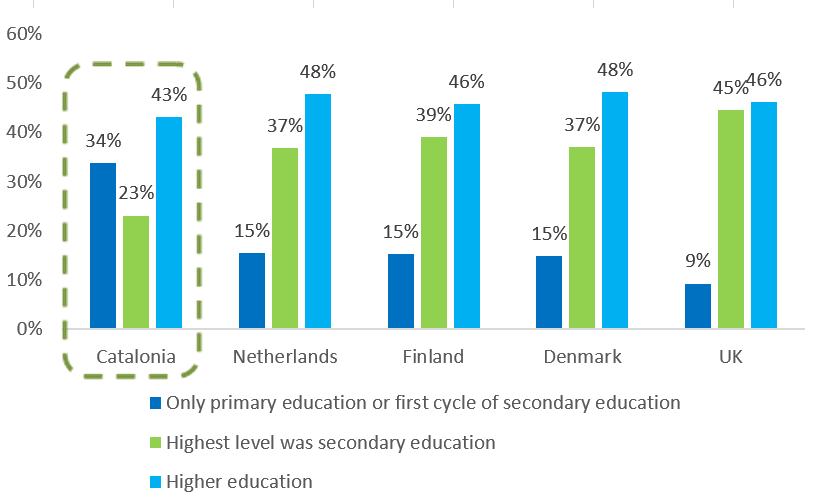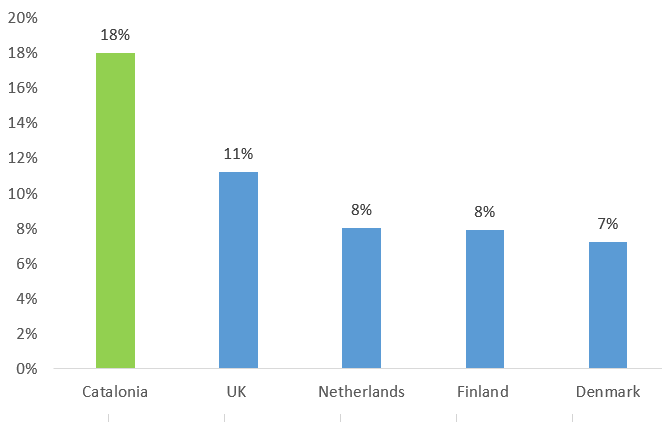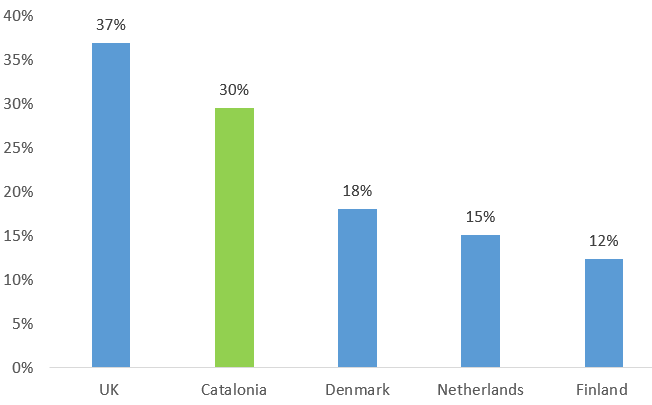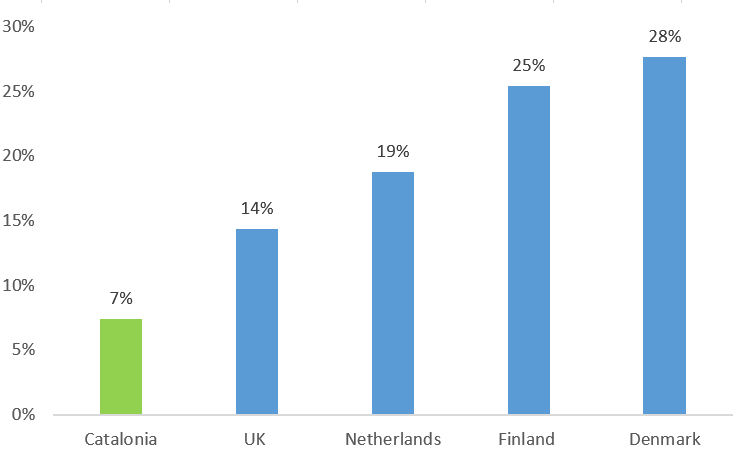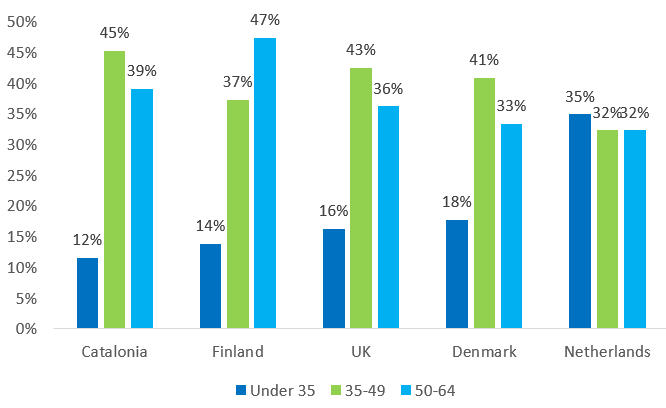89
April 2018
ARTICLES
Catalonia and four countries. Various facts and figures
Editorial Department - AQU Catalunya
The purpose of this report is to facilitate a comparative analysis of Catalonia with Denmark, Netherlands, Finland and the UK concerning several aspects of the situation of the universities and, according to the circumstances, higher education as a whole.
It presents a simple compilation of data and figures that highlight various challenges given the current situation. Although these aspects are not unfamiliar, the aim here is to quantify and adjust them over time for the purposes, where applicable, of regular trend monitoring. This report on teaching is to be followed up with a report on research.
The report covers an analysis of the following aspects:
1. 10 years of population growth and a changing trend in the age group between 0 to 14
In the period from 2000-2016 the percentage of the population between the ages of 0-14 in Catalonia increased at a higher rate than in Spain as a whole, as well as the euro zone and the European Union (an increase from 13.9% to 15.9%). Despite this increase in Catalonia, however, there was a decrease over the last ten years, especially from 2012 onwards and in the age group between 0-4 years (from 427,316 in 2012 to 375,265 in 2016, or a decrease of 52,051).
Taking into account the different factors affecting the increase in population, according to the Idescat age groups forecasts during the 2016-2026 period, the number of people between the ages of 0-15 is expected to decrease by 107,529 people, from 1,258,952 to 1,151,423. This may have a significant effect on the demand for higher education, at least in terms of the impact of demography.
According to Eurostat, this changing trend is already occurring in other countries.
Four possible correctives to this downward trend stand out:
- A higher propensity to study: the trend in the pursuit of higher education, driven by the desire for knowledge and better career prospects, has resulted in significant progress in Catalonia, which now finds itself on a similar level to the four countries it is being compared to in this study. On the other hand, it is in pre-university education where attention needs to be placed; for example, the percentage of the age group between 30-34 with just a primary education or that had completed the first cycle of secondary education was significantly higher than in the other four countries, and the percentage of the population for which the highest level of education was secondary was considerably lower.
Graph 1. Level of education of the population between the ages of 30 and 34. 2016
Source: Eurostat
- The decrease in the drop-out rate: This important difference between the education attainment levels may be due to a high premature drop-out rate, and one that is much higher in Catalonia than in the four countries in the study.
Graph 2. Drop-out rate. 2016
Source: Eurostat
There was however a significant improvement in Catalonia, where the figure for 2001 was 30.3%, compared to 18% in 2016.
- Attracting foreign students: Higher education marketing to attract foreign students as part of the process of progressive internationalisation by the universities in Catalonia resulted in a very high percentage of admissions by foreign students in 2015-2016, which in this study was only higher in the case of the UK.
Graph 3. Foreign student admissions. 2016
Source: Uneix and OECD
- Lifelong learning: the indicator available at Eurostat is the percentage of the population aged 25 to 64 who state they have received education or training in the preceding four weeks (i.e. prior to the corresponding survey). In Catalonia, this was somewhat lower.
Graph 4. Percentage of the population aged 25 to 64 who stated they have received education or training in the preceding four weeks
Source: Eurostat
2. The age of teaching staff
Budgetary constraints caused by the economic crisis in recent years has been a hindrance to staff turnover and resulted in a progressive increase in the age of teaching staff. From an analysis of the data it can be seen that, in 2016, the percentage of teaching staff aged under 35 was lower in Catalonia than in the other countries (12%), whereas the highest percentage (45%) of academics was concentrated in the 35 to 49 age group, followed by senior teaching staff in the 50 to 64 age group (39%).
Graph 5. Age of university teaching staff
Source: UNEIX and Eurostat
3. Distribution uniformity according to subject areas
In all of the countries covered by the study, the subject area with most students was Social Sciences, followed by Engineering and Architecture, Health Sciences, Experimental Sciences and, lastly, Humanities.
4. Financial resources for higher education
Bearing in mind that the two main figures for calculating the economic indicators are university budgets and GDP and the fact that, during the period from 2001 to 2015, recognised liabilities in the budgets settled by the seven public universities as a whole increased by 53.4% compared to the GDP which, at current prices, increased by 57.2%, it would appear that, due to the impact of the crisis on the budgets of the Government of Catalonia (Generalitat de Catalunya), it is unlikely that expenditure on higher education as a percentage of GDP in Catalonia has improved.
5. Grants and the cost of courses
In the EU-22 as a whole there was a significant increase in private funding for higher education compared to public funding in the period from 2008 to 2014. In this period, private funding increased from an indexed level of 97 to 113 in 2012, compared to public funding which grew from 99 to 100 (with a base index of 100).
The cost of courses and grant amounts vary according to the type of studies and whether programmes are full or part-time, as well as a student's family situation.
For the 2017-2018 academic year in Catalonia, the mean cost of an undergraduate programme is €2,123.
With regard to grants, the average for general grants in Catalonia, according to a AGAUR (University and Research Grants Management Agency) report, is €1,480, which can be supplemented by equity grants and zero interest loans.
Price of studies (year 2017-2018)
| Catalonia | Average price of Bachelor degrees: 2.123 euros |
| Denmark | Free, both for first and second cycle, for full-time students |
| Finland | Free, both for first and second cycle, for full.time students |
| Netherlands* | Between € 1.185 and € 2.006 |
| United Kingdom |
First cycle: England and Wales: € 9.800 Second cycle: € 4.500 |
* Source: National Student Fee and Support Systems in European Higher Education
Grants (2016)
| Catalonia* | Beques de 2.459 euros, complementades amb beques d'equitat i préstecs a interès zero |
| Denmark | Between € 1.507 and € 9.703 |
| Finland | Grants of € 10.908, of which € 5.100 are loans |
| Netherlands | Grants of € 3.100 and loans ascending to € 12.500 |
| United Kingdom | England: loans ascending to € 11.000 Wales: grants of € 5.595 Northern Ireland: grants of € 3.767 Scotland: grants of € 1.897 |
* Source: AGAUR 2016



